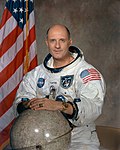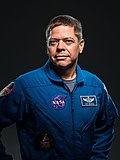History
When Deke Slayton was grounded from the Mercury Seven due to a heart condition, he took on the position of Coordinator of Astronaut Activities and informally held the title of "chief astronaut". In this role, he held responsibility for the operation of the astronaut office. [2]
The position of Chief of the Astronaut Office was officially created in July 1964, when Alan Shepard was named as the first Chief Astronaut. His responsibilities included monitoring the coordination, scheduling, and control of all activities involving NASA astronauts. This included monitoring the development and implementation of training programs to assure the flight readiness of pilot and non-pilot personnel for space flights; furnishing pilot evaluations applicable to the design, construction, and operations of spacecraft systems and related equipment; and providing scientific and engineering observations to facilitate mission planning, formulation of operational procedures, and selection and conduct of experiments for each flight. [3]
The Chief of the Astronaut Office often returns to active duty once their term is complete.
This page is based on this
Wikipedia article Text is available under the
CC BY-SA 4.0 license; additional terms may apply.
Images, videos and audio are available under their respective licenses.



















